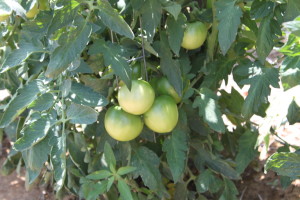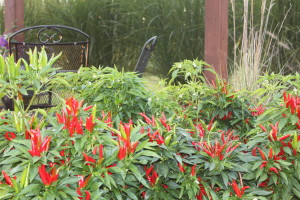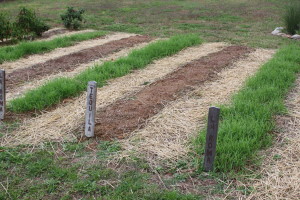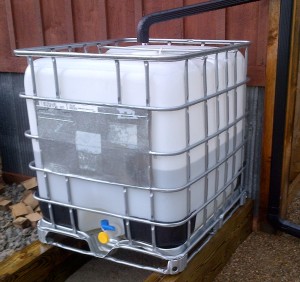How To Self Sufficent Garden
It's not that hard or costly to create a self sustaining garden, really!
Contrary to popular belief, gardening does not have to be an expensive venture! Especially when using self-sustaining, organic methods that can keep your soil full of life, and your family fed with fresh vegetables the year around.

Organically grown tomatoes ready to ripen on the vine
A truly self sustaining garden is organic by its very own nature. After all, it's hard to consider the act of dumping large amounts of petroleum-based synthetic fertilizers and soil additives a self sustaining garden process.
Not only are all of those aforementioned substances far from renewable – they are expensive – and you will find yourself utilizing increasing amounts each season just to get the same results.
In fact, unlike renewable organic methods that create great soil inexpensively, expensive commercial and synthetic products often leave the soil lifeless.
The great news – you don't have to worry about buying any of those products. And the benefits of gardening in a more self-sustaining, organic way will not only increase your garden's long-term success – it will have a positive impact on the health of the produce coming out of it – and your pocketbook!
With a little effort, you can secure all of the organic materials you will ever need for your garden at little to no cost. At the same time you can grow most of your own plants from your own saved seeds – create your own natural fertilizers and bug repellents nearly free, and even water your plants and landscape with H2O from mother nature – and not your local municipalities costly treated water.
So with that said – here are some great ways to create a self-sustaining garden without having to spend a lot of cash!
The Keys To Creating A Self Sustaining Garden
Start By Building Your Soil Naturally:
"Take care of your soil – and it will take care of you." For a long-term productive and successful garden – those words say it all.
Soil is the basis for everything that can go right or wrong in a garden – and it doesn't have to cost you an arm and a leg to create it.
In fact, you can build great vitality and health into your soil by practicing the three simple low-cost methods listed below.
Compost

Good soil promotes lush growth and big yields
Compost brings life and vitality to your soil! It's not only easy to make – but can me made for free! (See: 8 Great Tips To Finding Free Compost Materials)
Add a shovel full of compost to each of your planting holes every Spring to give lasting nutrients to your veggies as they grow.
It also makes an incredible mulch around plants – not only holding moisture in while holding back weeds – but supplying the plant with nutrients that leach into the soil and the plant's roots.
In the fall – if you have enough – top dress your planting rows with more compost to give life back to the just farmed soil. If you are starting new, use a good compost starter to get your pile off to a great start.
Mulch
Shredded leaves, straw, compost and grass clippings are all excellent mulches that not only help control weeds and feed your plants – but also add valuable organic matter back into your soil as they decompose.

We use a cover crop of annual rye each fall to add soil structure and nutrients back into the soil
With a little work – you can usually find all the free mulch material you need from local landscapers, or by picking up fall leaves and storing them.
Use Inexpensive Cover Crops / Green Manure Crops
This is a BIG one! Cover crops, when planted in the fall or as a quick green manure crop in the spring and turned over – are the perfect way to replenish your soil from the summer's garden.
Annual rye, clover, alfalfa or other choice cover crops are the lifeblood of a sustainable garden. Seed is extremely inexpensive (far less than a single bag of fertilizer!) and they have additional benefits as well, such as keeping out weeds, preventing soil erosion, and helping to fix nitrogen in the soil so that plants can soak it up. (See: Cover Crop Basics)
Watering For Free – Rainwater Water Collection System

We water everything at the farm completely from collected rain water
While you are at it – consider installing a simple rain-water collection barrel to your house or barn. Rainwater is an excellent choice to water your garden with – and by collecting your own – it's another free resource to have for your garden!
We installed two inexpensive totes to our barn's gutter a few years back – and they now water not only our entire garden throughout the year – but every hanging basket, potted plant, tree and more on our property – all for free. (See: Creating a Simple and Inexpensive Water Collection System)
Saving Seeds / Growing Your Own Plants
When it comes to the plants you grow each year – there is little need to have to spend large amounts of money when you can save and grow your own plants from seed.
The key is picking open-pollinated (often called heirloom) varieties that can be saved and replanted time and again.
Crops like garlic and potatoes tend to get stronger and more productive the longer they are grown and re-seeded into your soil each year.
Even if you do have to purchase a few packs each year to start new varieties, or to get started – they are inexpensive compared to buying established plants in nurseries every garden season.
(See: The Basics of Saving Seeds)
Home Made Natural Fertilizers and Sprays
When it comes to sprays and fertilizers – first let me say that if you begin to practice self-sustaining organic methods – pests and soil fertility issues will be more than likely be minimal.
Strong, healthy plants are much more resistant to damage from pests, which prey on weak species. And of course, if they are strong and healthy – there is no need for additional fertilizing!
But if and when the time comes that you must use something in your garden – there are ways to do it that are healthier and much cheaper than commercial alternatives.
It has been a while since we have ever had to use it – but when we have had a few problems here and there with aphids or other pests – we use a simple, safe and effective home-made bug spray made from hot peppers and garlic . (See: Home Made Bug Spray Recipe)
For fertilizer, we use a simple solution of compost tea on all of our vegetable plants in the early spring to give them a boost. It's simple to make, completely free, and gives them just a boost of nutrients to get them off to a great start. (See: How to Make Compost Tea)
So you see, it doesn't have to cost a fortune to grow your own healthy vegetables!
If you would like to receive our DIY & Gardening Tips each week – be sure to sign up to follow the blog via email in the right hand column, "like" us on Facebook, or follow us on Twitter. This post may contain affiliate links.
Happy Organic and Self Sustaining Gardening!!! Jim and Mary
How To Self Sufficent Garden
Source: https://oldworldgardenfarms.com/2014/07/30/self-sustaining-garden/
Posted by: nicholsdocklinew.blogspot.com

0 Response to "How To Self Sufficent Garden"
Post a Comment